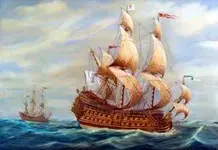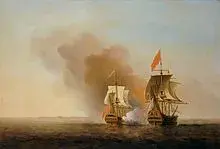Honest Samuel
Banned
- Joined
- Sep 23, 2015
- Messages
- 8,808
- Reaction score
- 4,971
- Golden Thread
- 0
- Location
- Connecticut
- Detector(s) used
- Minelab
- Primary Interest:
- All Treasure Hunting
Leave poor Captain Kidd out of this. He suffer enough.

There is an excellent (and historically accurate) book by Richard Zacks titled "The Pirate Hunter: The True Story of Captain Kidd" that describes William Kidd's last few years. He got railroaded by his backers (in Parliament) and took the fall. Any treasure he had from the Quedagh Merchant was likely mainly silk, muslin, satin and spices. None of which would bury well. Certainly some silver as well.
He was not a pirate. The papers he captured were his evidence it was a French backed ship but he was not allowed to present them in his trial. They were auctioned off with the cargo in London and exist today - showing his innocence (privateer vs. pirate, anyway).


George Anson capture of the Nuestra Señora de Covadonga
View attachment 1389378
George Anson, the creator of the Shugborough monument . . .
Accept Anything Written Down in a History Book
George financed it. His brother commissioned it and Scheemakers was the sculptor.
George Anson died in 1762. What did he use to base his "coordinates" on? Where did he place 0° longitude? Some countries used the Azores, some the Canaries. "Greenwich" wasn't adapted by England until 1765 (after Anson's death) and the rest of the world in 1851. In 1721 the Royal Observatory was N0°0" (in 1851 it was "officially" centered in Airy circle - but that didn't exist in the 1700's. It was centered on the observatory building in Anson's time). But they were all relatively close in British Fleet use so we'll call that a "gimmie".
So, to have a coordinate with just degrees and minutes? Coordinates take a pair of numbers: latitude and longitude. And also a Prefix to each of those (North or South of the Equator, East (+) or West(-) of the Prime Meridian) But just assuming it was a coordinate: eight characters in the OUOSVAVV "code". You need one to three for the degrees (0 to 360°) and two for minutes (0 to 60'). With degrees and minutes (even with the additional "gimmie" it was northern hemisphere) it will only get you to within 1/21,600th of the earth's circumference - or 1.15 miles (or 1.0 nautical mile). So you have a square mile assuming lat/long coordinates.
So, assuming Anson had a treasure - why would a British Admiral and Baron choose (Acadia - "New France") a colony of a country his country was at war with (actively when he died) to bury a treasure? Or is the assumption this was buried before it was New France (which would have been under papal decree to be Spanish territory - also not a good neighbor of Great Britain)?
Since this is an Oak Island thread: N44°31' W64°18' gets you on Oak Island with 1/4 mile of water bordering a 1 x 1 nautical mile box. Does that relate to OUOSVAVV in any way?
Or, is it an Acronym for the Latin "Orator Ut Omnia Sunt Vanitas Ait Vanitas Vanitatum" (Ecclesiastes 12:8)? "Vanity of vanities, saith the preacher; all is vanity".
For years people have tried to complicate the Shugborough Code but the clue to the system is right there, the 'D' and the 'M'. You are correct in that without seconds you cannot get extremely close, but at the time you could not get very close with Longitude anyway.
Even assuming we can assume Western and Northern Hemispheres or even using just the NE portion of North America, then what degree and minute numbers do you associate with the "OUOSVAVV" that would be uncomplicated?
The coordinates of Oak Island are N44°31' / W64°18' or N44°31', -64°18' depending how you present it.
Can you back cryptograph that set of coordinates? Giant assumption it related to Oak Island and not some other spot on Earth.
Don't see it. OU OS VA VV <> 44 32 63 43
And are they pointing at coordinates? No.
Why reversed? Artistic license. Or he did a transfer and rubbed the carbon lines onto the stone to lay out the pattern.
So, assuming Anson had a treasure - why would a British Admiral and Baron choose (Acadia - "New France") a colony of a country his country was at war with (actively when he died) to bury a treasure? Or is the assumption this was buried before it was New France (which would have been under papal decree to be Spanish territory - also not a good neighbor of Great Britain)?
Rosebud?
